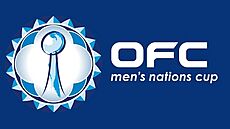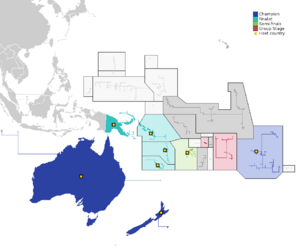OFC Men's Nations Cup facts for kids
 |
|
| Organising body | OFC |
|---|---|
| Founded | 1973 |
| Region | Oceania |
| Number of teams | 8 (finals) 11 (qualification) |
| Related competitions | OFC Women's Nations Cup |
| Current champions | |
| Most successful team(s) | |
| Television broadcasters | FIFA+ |
The OFC Men's Nations Cup is a big football tournament for men's national teams in Oceania. It's organized by the Oceania Football Confederation (OFC). The team that wins becomes the champion of Oceania. Until 2016, the winner also got to play in the FIFA Confederations Cup, which was another important international tournament.
For a long time, Australia and New Zealand were much stronger than other teams in Oceania. Because of this, the tournament didn't get much attention from the rest of the football world. The 2012 OFC Nations Cup was special because Tahiti won it. This was the only time a team other than New Zealand or Australia has won the cup.
Contents
History of the Tournament
Early Years (1973–1980)
The tournament started in 1973 and was called the "Oceania Cup." The first event didn't have any qualifying games. Auckland, New Zealand, hosted it, and New Zealand won by beating Tahiti 2–0 in the final. Some teams that weren't part of FIFA, like New Hebrides (now Vanuatu), also played.
The second Oceania Cup happened in 1980 in New Caledonia. Australia won the final match in Nouméa, beating Tahiti 4–2. New Zealand didn't do well in this tournament. They lost to Tahiti and Fiji in the group stage. However, two years later, they qualified for the 1982 FIFA World Cup. These first two tournaments were the only ones without qualifying rounds. After 1980, the tournament stopped for a while. Australia remained the Oceania Champion for 16 years without playing. During this break (1981–1995), the most important tournament in Oceania was the Trans-Tasman Cup, played only between Australia and New Zealand.
The Cup Returns (1996–2004)
In 1996, the OFC became an official confederation for FIFA. The tournament came back as the "Oceania Nations Cup." It also became a way for teams to qualify for the Confederations Cup. The 1996 tournament didn't have one host country. It had a new qualifying round. Four teams played in semi-finals and a final, with each game played twice (home and away). Australia easily won the final against Tahiti, with scores of 6–0 and 5–0. Kris Trajanovski from Australia scored seven goals in the final games. Australia then played in the 1997 FIFA Confederations Cup.
In 1998, six teams played in Australia. Australia and New Zealand were the strongest teams. In the final in Brisbane, New Zealand beat Australia 1–0. Damian Mori from Australia scored 10 goals in this tournament, which is still a record. He is also the top scorer in the history of the Oceania Nations Cup with 14 goals.
The fifth tournament was in Tahiti in 2000. Australia and New Zealand again reached the final in Papeete. Australia won their third title 2–0, which sent them to the 2001 FIFA Confederations Cup. Fiji had to pull out of the tournament because of a civil war. Vanuatu took their place and played well against Australia in the semi-final. Australia only won 1–0 with a penalty kick.
For the 2002 tournament in New Zealand, eight teams played in two groups. Australia and New Zealand won their groups and met in the final for the third time in a row. Australia had financial problems, and their players had to pay their own way to New Zealand. This meant they had a weaker team. New Zealand won the final 1–0 in Auckland with a late goal.
The 2004 tournament was also a qualifier for the 2006 FIFA World Cup. It was played in Australia. Six teams played in one group. The top two teams played a final match over two games. Vanuatu surprisingly beat New Zealand 4–2 in the group stage. This helped Solomon Islands get to the final against Australia. Australia won the final easily, 5–1 in Honiara and 6–0 in Sydney. This was Australia's fourth and last OFC title. In 2006, Australia joined the AFC, which changed football in Oceania a lot.
A New Era (2006–Present)
When Australia left the OFC in 2006, New Zealand became the main strong team in Oceania. The 2007 South Pacific Games helped teams qualify for the 2008 OFC Nations Cup. The 2008 tournament didn't have one host. Four teams played each other home and away in one group. This tournament also helped teams qualify for the 2010 FIFA World Cup. New Zealand won easily, winning five out of six matches. Fiji surprisingly beat New Zealand 2–0 in their last match. Shane Smeltz from New Zealand was the top scorer with eight goals.
The 2012 OFC Nations Cup was supposed to be in Fiji, but it was moved to the Solomon Islands. Eight teams played in two groups. The top two teams from each group went to the semi-finals. Tahiti and New Caledonia reached the final in Lawson Tama Stadium. Tahiti won 1–0 with a goal from Steevy Chong Hue. This made Tahiti the first team other than Australia or New Zealand to win the Oceania championship. This tournament also helped teams qualify for the 2014 FIFA World Cup.
The 2020 OFC Nations Cup was cancelled. The tournament was confirmed to return in 2024 as the 2024 OFC Men's Nations Cup. This tournament will follow a similar style but will not be a World Cup qualifier.
How the Tournament Works
The first two tournaments in 1973 and 1980 didn't have any qualifying rounds. For the next three tournaments, Australia and New Zealand automatically got a spot. The other ten teams played in qualifying rounds. The Polynesia Cup and Melanesia Cup were used as qualifiers. Teams played in groups based on their location, and the top two teams from each qualified for the OFC Nations Cup.
In 2002, the format changed. FIFA rankings decided how all twelve teams were seeded. The six lower-ranked teams played a group stage, and two qualified for the main tournament. The 2002 Cup had two groups of four teams. After the group stage, there was a knockout stage for the top four teams.
In 2004, the format changed again. It went back to being similar to the 1996–2000 tournaments. Five teams played in two qualifying groups, and Australia and New Zealand were already in the main tournament. The main tournament was a group stage with six teams. The top two teams played a final match over two games (home and away). This tournament also served as a qualifying round for the 2006 FIFA World Cup.
For the 2008 tournament, the format changed once more. The Football at the 2007 South Pacific Games was used as a qualifying tournament. The gold, silver, and bronze medal winners went to the main tournament. New Zealand automatically qualified. New Zealand won the 2008 OFC Nations Cup. They then qualified for the 2009 FIFA Confederations Cup.
| Year | Teams | Matches | Format |
|---|---|---|---|
| 1973 | 5 | 12 | round-robin group of 5, 3rd-place match, final |
| 1980 | 8 | 14 | 2 groups of 4, 3rd-place match, final |
| 1996 | 4 | 6 | two-legged semi-finals, two-legged final |
| 1998 | 6 | 10 | 2 groups of 3, semi-finals, 3rd-place match, final |
| 2000 | 6 | 10 | |
| 2002 | 8 | 16 | 2 groups of 4, semi-finals, 3rd-place match, final |
| 2004 | 6 | 17 | round-robin group of 6, two-legged final |
| 2008 | 4 | 12 | double round-robin group of 4 |
| 2012 | 8 | 16 | 2 groups of 4, semi-finals, 3rd-place match, final |
| 2016 | 8 | 15 | 2 groups of 4, semi-finals, final |
| 2024 | 7 | 13 | 2 groups of 3–4, semi-finals, 3rd-place match, final |
Tournament Results
- The 2004 tournament was a round-robin tournament in Australia. The top two teams then played a final over two games.
Summary of Winners
| Team | Winner | Runners-up | Third place | Fourth place | Semi-finalist | Top 4 Total |
|---|---|---|---|---|---|---|
| 6 (1973, 1998, 2002, 2008, 2016, 2024) | 1 (2000) | 2 (2004, 2012) | N/A | 1 (1996) | 10 | |
| 4 (1980, 1996, 2000, 2004) | 2 (1998, 2002) | N/A | N/A | N/A | 6 | |
| 1 (2012) | 3 (1973, 1980, 1996) | 2 (2002, 2024) | 1 (1998) | N/A | 7 | |
| N/A | 2 (2008, 2012) | 2 (1973, 1980) | N/A | 1 (2016) | 5 | |
| N/A | 1 (2004) | 1 (2000) | 1 (2012) | 2 (1996, 2016) | 5 | |
| N/A | 1 (2016) | N/A | N/A | N/A | 1 | |
| N/A | 1 (2024) | N/A | 4 (1973, 2000, 2002, 2008) | N/A | 5 | |
| N/A | N/A | 2 (1998, 2008) | 3 (1980, 2004, 2024) | N/A | 5 |
Notes:
Bold text means the team was the host country.
1 Australia left the OFC in 2006. They became a full member of the AFC.
Records and Statistics
Awards Given
After each tournament, four special awards are given out:
- The Best Player award for the most valuable player.
- The Top Goalscorer award for the player who scores the most goals.
- The Best Goalkeeper award for the best goalkeeper.
- The Fair Play Award for the team that shows the best sportsmanship.
See also
 In Spanish: Copa de las Naciones de la OFC para niños
In Spanish: Copa de las Naciones de la OFC para niños


